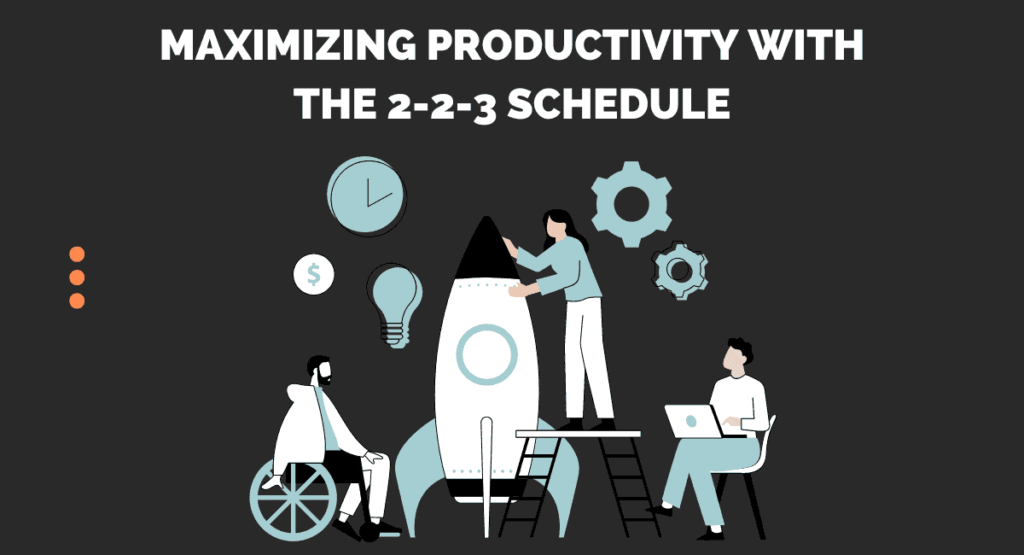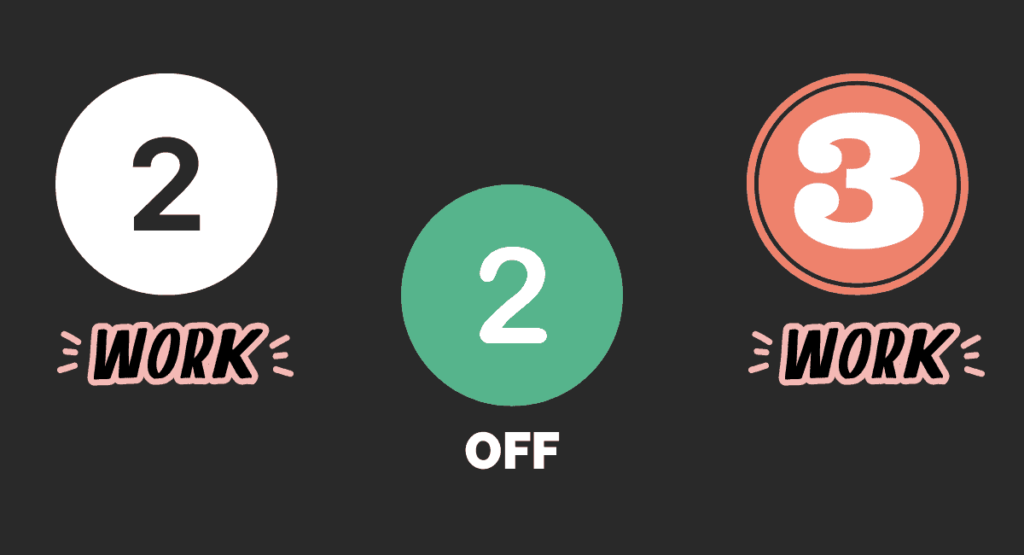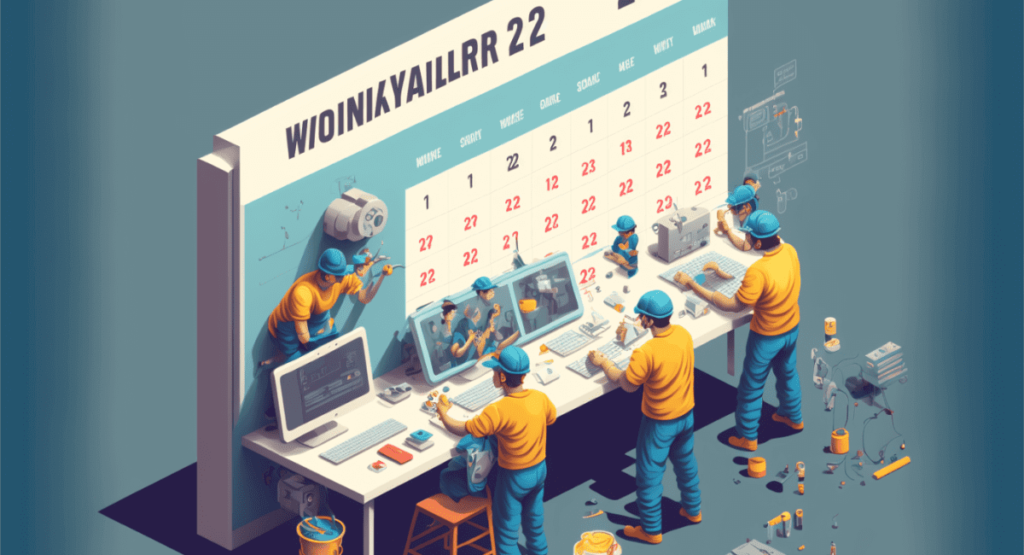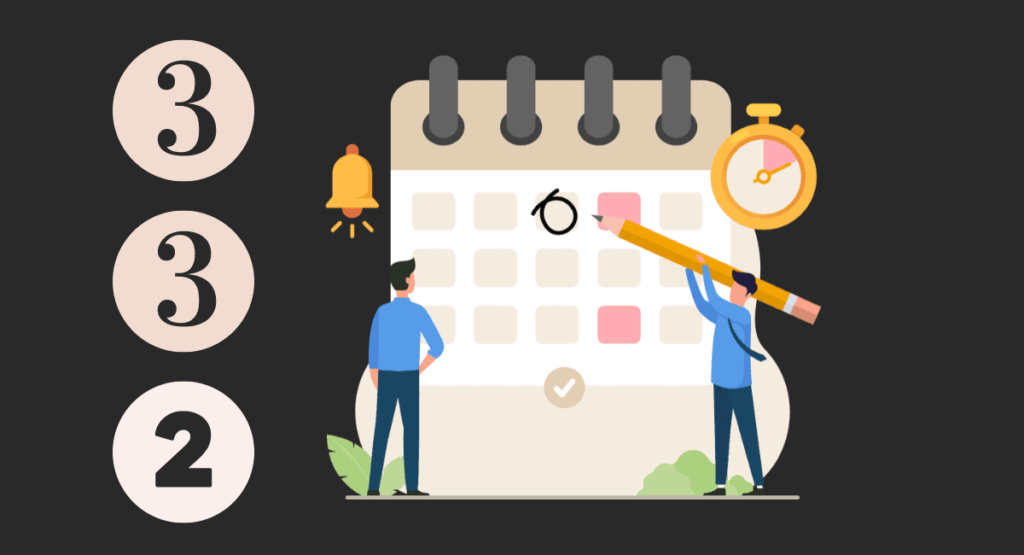Maximizing Productivity with the 2-2-3 Schedule


Are you feeling overwhelmed with work and trying to find a way to improve your productivity and work-life balance?
The 2-2-3 schedule may be the answer you’re looking for! This unique schedule involves working two days, taking two days off, and then working three days in a row, allowing for a better balance between work and leisure.
Not only does this schedule increase productivity, but it also helps to prevent burnout and enhances creativity. In this article, we’ll explain what the 2-2-3 schedule is and how it can benefit you and your team.
We’ll also discuss how you can implement it in your workplace and strategies for overcoming challenges.
Keep reading to learn how to maximize productivity and achieve a better work-life balance today!
What is the 2-2-3 schedule, and how does it work?

The 2-2-3 schedule, also known as the “rotating schedule,” is a unique scheduling method that involves working two days, taking two days off, and then working three days in a row.
This schedule differs from traditional schedules such as the 5-day workweek and allows for a better balance between work and leisure.
To implement this schedule in your workplace, you must first communicate the plan with your team and management. Adjusting the schedule to accommodate your team’s needs and workload may be necessary. Once the schedule is in place, sticking to it and maintaining consistency is essential.
One of the key benefits of the 2-2-3 schedule is that it allows for increased productivity. The schedule allows for longer stretches of focus and concentration during the workdays, reducing the time spent switching between tasks and activities.
Additionally, the schedule helps to prevent burnout by providing regular breaks and time for rest.
The schedule also promotes better work-life balance. The schedule allows for more time off to spend with family and friends, pursue hobbies, and take care of personal responsibilities. This can lead to increased happiness and well-being.
For those who are new to the 2-2-3 schedule, it may take some time to adjust. It can be challenging to get used to the new schedule, and it may take some time to find the right balance.
It’s essential to be patient and give it time to work. Also, it’s helpful to set a reminder or schedule to help you keep track of the schedule.
Considering implementing this schedule in your workplace, it’s essential to weigh the potential benefits and challenges. It would be a great way to increase productivity and improve work-life balance, but it may not be the right fit for every team or organization.
However, by understanding the schedule and its benefits, you can decide if it’s right for you and your team.
The Advantage of a 2-2-3 Schedule

The 2-2-3 schedule is a game-changer for productivity and work-life balance. This unique schedule involves working two days, taking two days off, and then working three days in a row.
It sounds like a dream come true, right?
Increase productivity
The most significant advantage of the rotating schedule is increased productivity. Having longer stretches of focus and concentration during workdays reduces the time spent switching between tasks and activities. The schedule is like having a superpower for getting things done.
Prevent burnout
Another advantage is that it helps to prevent burnout. The schedule provides regular breaks and time for relaxation, like hitting the reset button on your brain. This can lead to increased creativity, clearer thinking, and a better attitude toward work.
Work-life balance
The schedule also promotes better work-life balance. The schedule allows for more time off to spend with family and friends, pursue hobbies, and take care of personal responsibilities.
It’s important to note that the schedule may take some time, like learning a new language. It can be challenging to adjust to the new schedule, and it may take some time to find the right balance.
Potential Challenges and Solutions of the 2-2-3 Work Schedule

Like any new change, adjusting to the schedule takes time and effort, and it may not be the perfect fit for everyone. In this section, we will explore some potential challenges of the schedule and how to overcome them.
Internal coordination challenge
One potential challenge is coordinating with other team members. The schedule may not align with other team members’ schedules, making it difficult to schedule meetings and collaborate on projects.
A solution to this challenge is to use online communication tools such as video conferencing, instant messaging, and project management software to stay connected and productive.
Maintaining productivity for three days.

Another challenge is maintaining productivity during three consecutive workdays.
Maintaining focus and energy levels can be difficult, especially on the third day. A solution to this challenge is to schedule regular breaks and use time management techniques to stay on track.
Also, you can use tools like the Pomodoro Technique, a time management method that encourages you to work in short intervals, with regular breaks in between.
Maintaining Work-life balance
A third challenge is maintaining a work-life balance. The schedule can be difficult to balance with personal responsibilities and hobbies.
A solution to this challenge is to plan and schedule activities in advance. This way, you can make the most of your time off and enjoy your hobbies and personal responsibilities.
Not be the best fit for everyone.
Finally, the 2 2 3 work schedule may not be the best fit for everyone. Some people may need help adjusting to the schedule, which may not be practical for particular industries or job types.
In these cases, exploring other scheduling options and finding the best fit for you and your team is essential.
How can I overcome my coworkers or boss’s resistance to the 2-2-3 work schedule?

Overcoming resistance to the schedule from coworkers or a boss can be challenging, but it’s possible. Here are several tips to help you navigate this process:
Communicate the benefits
One of the main reasons people resist change is that they don’t understand the benefits. Communicate how the 2 2 3 work schedule can improve productivity, prevent burnout, and improve work-life balance. Use data and research to support your argument.
Address concerns
Listen to the concerns of your coworkers and boss, and address them thoughtfully and respectfully. Companies must be open to feedback and willing to make adjustments as needed.
Be a role model
Lead by example and show your coworkers and boss how the 2 2 3 work schedule can work for you. Show them how it can increase their productivity and improve their work-life balance.
Involve them in the process
If possible, involve your coworkers and boss in implementing the 2 2 3 work schedule. Their involvement will give them a sense of ownership and make them more likely to support the change.
Provide support
Provide your coworkers and boss with the resources and support needed to adapt to the new schedule. The resources can include training, tools, and support from management.
These tips can overcome resistance to the 2 2 3 work schedule and create a more productive and balanced workplace. Change can be difficult, but growth and improvement are often necessary. Be patient and persistent, and you’ll be able to achieve your goals.
Variations of the 2-2-3 workweek

Variations of this schedule can be implemented depending on the organization’s and its employees’ needs.
One variation is the 2-3-2 schedule, similar to the 2 2 3 work schedule, with an additional day of work in the middle of the week. This schedule can benefit organizations that need more coverage during the week but still want to provide employees with an excellent work-life balance.
3-2-2 schedule
Another variation is the 3-2-2 schedule; employees work for three days, have two days off, and again work for three days. The 3-2-2 schedule can benefit employees who want a long weekend and more time to spend with family and friends.
4-3 schedule
Another variation is the 4-3 schedule, also known as the 9/80 schedule. This schedule allows employees to work four days, have three days off, and work four days. This schedule can benefit employees who want to have a long weekend but still want to work a standard eight-hour workday.
Who uses the 2-2-3 shift pattern?

“So if someone doesn’t like the 2-2-3 schedule, they quit full time and go casual. And nurses have the power to do that, because the system has no choice but to hire them back. There are full time positions that cannot be filled.” Billy Gosse.
The 2-2-3 shift pattern is a flexible work schedule commonly used in industries requiring around-the-clock coverage, such as manufacturing, healthcare, and emergency services.
The schedule allows employees to work two days, have two days off, and work three days, providing a good balance between work and personal time.
Manufacturing Industry
Manufacturing companies often use the 2 2 3 work schedule to ensure that their production lines run smoothly and efficiently. This schedule allows them to have a consistent workforce during the week and minimize downtime.
Healthcare Industry
Healthcare organizations such as hospitals, clinics, and nursing homes also use the 2 2 3 work schedule to provide around-the-clock patient coverage. This schedule allows them to have a consistent workforce during the week, which can improve patient care and satisfaction.
Emergency Services
Emergency services, such as fire departments and police departments, also use the 2 2 3 work schedule to ensure that they have enough personnel on duty to respond to emergencies.
This schedule allows them to have a consistent workforce during the week, which can improve response times and safety for both their personnel and the community.
Retail, logistics, and customer service
In addition to the industries mentioned above, other companies such as retail, logistics, and customer service may also use the 2 2 3 work schedule to ensure they have enough coverage during peak periods.
This schedule allows them to have a consistent workforce during the week, which can improve customer satisfaction and productivity.
In conclusion, the 2 2 3 shift pattern is a popular schedule used in industries that require around-the-clock coverage. This schedule allows them to have a consistent workforce.
Tips for Implementing a 2-2-3 Work Schedule

Implementing a 2-2-3 work schedule can benefit employees and employers, but it can also be challenging to coordinate. Here are the tips to help you successfully implement this schedule in your workplace:
Communicate clearly with your employees: Explain the benefits of the 2 2 3 work schedule and how it will impact their work schedule. This will help prevent confusion and ensure everyone is on the same page.
Be flexible: The 2 2 3 work schedule can benefit employees with family responsibilities, but it may not be suitable for everyone. Be open to accommodating and listen to feedback from your employees to ensure that the schedule works for everyone.
Plan ahead: Make sure you have enough coverage for each shift and that the schedule is balanced so that no one is overworked. You can create a schedule that rotates employees through different shifts and considers their availability.
Provide training: Provide training for employees on how to manage their time and adapt to the new schedule. This will help them to be more productive and efficient.
Monitor progress: Keep track of employee satisfaction, productivity, and attendance to ensure that the 2 2 3 work schedule works well. Make adjustments as needed, so the schedule meets the needs of your employees and your organization.
Encourage a positive work culture: Reward employees for their hard work and provide opportunities for them to socialize, bond, and build a sense of belonging.
Pitman Shift Schedule

The Pitman Shift Schedule is a rotating schedule often used in healthcare, manufacturing, and emergency services industries. The inventor of this schedule is Dr. George Pitman, who first proposed it in the early 20th century.
The Pitman schedule runs around a three-team system, with each team working two consecutive days, followed by two days off.
The teams then rotate through different shifts, such as days, afternoons, and nights. This schedule allows for regular and consistent breaks, which can help prevent employee fatigue and burnout.
However, it can also disrupt an individual’s personal and family life, as it only sometimes aligns with the traditional workweek schedule.
Employers should support their employees who work on the Pitman shift schedule, such as providing regular breaks, scheduling shifts in a way that allows for adequate rest and recovery time, and offering flexibility in scheduling to accommodate employees’ personal and family needs.
Dupont Shift Schedule

The Dupont Shift Schedule is a work schedule that alternates between different shifts over a period of time. Dupont implemented this schedule in the 1940s.
Here’s how it works: employees rotate between three different shifts, typically working one week on the day shift, one week on the evening shift, and one week on the night shift. This rotation repeats itself every three weeks.
So, why would a company use this schedule?
Well, it allows for 24/7 coverage with a smaller number of employees. Plus, it helps to prevent burnout by giving employees a change of pace and different hours to work.
You’ll never be bored with the same schedule!
Conclusion
In conclusion, the 2-2-3 schedule is a unique and efficient way to organize work schedules. It allows for a better work-life balance, improved productivity, and increased employee satisfaction.
However, it can also come with challenges, such as resistance from coworkers or difficulty coordinating schedules. By understanding the benefits and potential obstacles, employers and employees can work together to implement a 2-2-3 schedule successfully.
Remember, shift work is not a size fits all. Dupont and Pitman’s schedules are other options that companies could consider.
And if you’re still feeling confused, remember that a 2-2 shift is just like a see-saw, you work two days, then you have two days off, and then you work three days. Just make sure you’re having fun and not getting too “shift-faced”!


